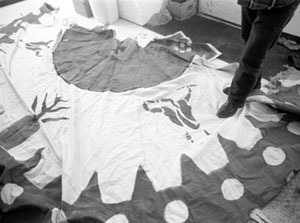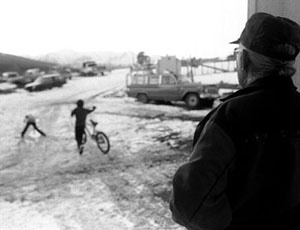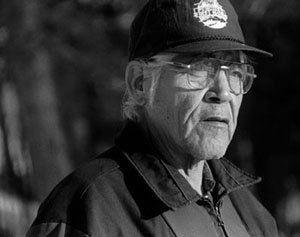 |
Defining a Nation
Ancestry, language and
tradition are the
distinctions that make a person Blackfeet
Story by Katja Stromnes
Photos by Lem Price
In 1934,
when the government agent came to the Blackfeet Reservation,
he told tribal leaders to identify the Blackfeet people and put
them on their rolls.
So the Blackfeet Tribal Council sat down and set the criteria
to be Blackfeet. Then they called forth their people. In a book
the Blackfeet signed their names and those of their deceased
family members.
From that day forward, the council said, an Indian must have
a parent or a grandparent in the book to be a tribal member.
But in 1962, the federal government added a provision, saying
anyone born into the tribe must also have a quarter Blackfeet
blood to claim membership.
"Western law has us broken down into pedigree,"
says G.G. Kipp, a Blackfeet ceremonial leader. "But that's
not our traditional way."
What makes someone Blackfeet is not just blood quantum, Kipp
and others say. It's language, cultural habits and lineage, according
to Conrad LaFromboise, director of higher education for the Blackfeet
tribe.
The native view, he says, implies that if people can look
at their family history and identify Blackfeet ancestors, then
they are Blackfeet.
Blood quantum as the only measure doesn't bode well for the tribe's
future.
"Numerically, that's going to work out to zero at some
time," LaFromboise says, citing intermarriage.
So to Blackfeet like Kipp and LaFromboise, safeguarding a
distinct people means more than checking blood quantum.
And in a world where some Blackfeet children have their own web
pages to display their lineage, it's a task that isn't easy.
"We can go many places to learn to be a western man,
a western woman," LaFromboise says. "Where can we go
to learn to be a Blackfeet man, a Blackfeet woman?"
He says the task starts with approaching the elders, the grandparents
who know the language, because Blackfeet language is at the center
of what it means to be Indian.
"The language was lost," says Molly Bullshoe, a
73-year-old retired school teacher, remembering a time when Blackfeet
was the common tongue. "There are just a few who talk Blackfeet
fluently."
Leo and Molly Bullshoe speak Blackfeet to each other, but
English to their 11 children and 66 grandchildren. Their second
language was learned more than 70 years ago in Indian boarding
school.
"When I was 6 years old, I was put in the mission and
I thought I'd never see my parents again," Molly Bullshoe
says. "In the mission, if we talked Indian, we got punished.
I couldn't speak a word of English. But I had to learn."
When the couple met and began to raise their family, they
feared repercussions if they taught their children anything distinctly
Blackfeet.
LaFromboise says for the first half of this century most Blackfeet
children were sent to missionary schools. While some remained
in schools on the reservation, many were sent away. Their language
and religion were forbidden.
On the reservations, the federal government also banned Indian
ceremonies and traditions and LaFromboise says many people took
them underground.
"They wanted the Blackfeet to put away their heathen
ways and be christianized, civilized," LaFromboise says.
Once the government realized its termination and assimilation
policies had failed, the Bullshoe family, like many others on
the Blackfeet Reservation, revived tribal ceremonies and no longer
kept them hidden.
The two styles of life solidified by the elder Bullshoes are
what Leo Bullshoe thinks kept the family together through poverty
and hardship.
"The good couple pulls together," he says of his
marriage of 50 years. "It makes everything nice. Our happiness."
Today, many of the Bullshoes' children are raising their children
on their parents' land in the same way - with elements from both
white and Indian culture.
The Bullshoe clan lives in farmhouses on the land of their
ancestral clan, the Lone Tea Drinkers. For 24 years Molly Bullshoe
taught school, eventually teaching culture and language classes.
"I thought, well, an Indian teacher would know how to
help an Indian kid," she says. "That was my goal. Because
some Indian kids don't get the help from other teachers."
Her own grandchildren are learning things about their roots
that her children didn't. Granddaughter Elizabeth Bullshoe, 11,
recently asked her grandma to teach her the tribal language.
Her grandmother proudly answered yes, but told her it would take
time and patience.
The child's pride in her heritage is a trait uncommon in her
parents' generation.
"I grew up in the John Wayne era," says Willie Crawford,
the son of a traditionalist, who now openly practices Blackfeet
ceremonies. "Indians were always the bad guy. At one point,
I was ashamed to be an Indian, but I am getting my dignity back."
His grandmother, too, would not speak Blackfeet to him when
he was a boy.
"She was definitely afraid the government was going to
come in," he says. "My grandparents talked about the
missionaries. They made them kneel on broomsticks for hours if
they spoke their own language. They'd get stuck in a room for
days."
Not only was the language lost, so were family artifacts.
Crawford's father, Rice, still mourns the loss of the family's
Beaver Bundle, stolen from an uncle 40 years ago. Bundles are
made from the soft skin of an animal underbelly and hold inside
the family's sacred objects.
They are the most sacred tool of ceremonies that take place
after the first thunderstorm of spring. Passing on the meaning
of the bundle's contents, and thus the meaning of the ceremony,
isn't learned in one sitting, Rice Crawford says.
The elders know it takes years to teach the ceremony and parts
lost will never be recaptured.
Many artifacts were sold or stolen during a period in which
a flourishing market in Indian artifacts coincided with crushing
reservation poverty.
People were starving, especially during the Depression, Leo
Bullshoe says. His family survived on government rations as Leo
watched his father's cattle and horses sold so the family could
survive.
"Tradition died," says Molly Bullshoe. "In
those days, it was tempting to hustle for money." More artifacts
disappeared as times got tougher.
Today
Blackfeet like Rice Crawford attempt to carry on tradition in
ways that meld with modern life. They use traditions from the
past to make a living in the present. The Crawfords spend their
winters selling teepees and drums they make in the ways of their
ancestors. And the family has taught traditional ways to their
five grown sons, who will pass them on to their children.
Another traditionalist, Floyd Rider, is a healer. In his sweat
lodge, with the help of his ancestors, known as the "grandfathers,"
he uses prayer and ceremony to strengthen those who seek his
help.
Rider has never been afraid to practice his cultural traditions
because, unlike many Blackfeet children who were sent away to
school, Rider was kept home to work on his grandfather's ranch.
Raised Catholic, Rider says 30 years ago he awoke to traditional
healing ways on a four-day fast. He decided to ask the Creator
and the grandfathers for the ability to heal, and in exchange,
he promised to never refuse anyone in need.
Some say he works miracles, but Rider says healing relies
on faith.
He uses his sweat lodge several times a week. It's a long and
low lodge covered in thick orange carpets. It sits under a tent
above the Two Medicine River at the dead end of East Glacier's
main paved road.
"What you see out there is the only good thing up here,"
Rider says, gesturing away from the road and across the river
to the deep mountains where he fasts.
He says it might take a miracle to keep tradition alive on the
tough reservation caught between two worlds.
The devastation
of a lost of self respect and a government policy of relocation
hit a generation of adults. Encouraged by the federal government,
many Indians moved from the reservation to find employment. Still
others were mired in a rising epidemic of alcoholism. Renewing
a tribal tradition, the elder generation stepped in and filled
the gaps in family life.
In the late 1940s and '50s, this take on family cultivated
a phenomenon called "grandma-babies" that persists
today.
Grandma-babies are children born to parents who abandoned them.
LaFromboise says the grandma-baby originates from old traditions
of people passing their babies on to elders if they were having
a streak of bad luck.
Bob Tailfeathers, dean of student services at Blackfeet Community
College, says it's common.
"In my family right now," says Tailfeathers, "my
sister's considered grandma ... with the little kids. It's a
respectful thing."
A number of those Blackfeet raised in distant missionary schools
grew up to abandon their own children, LaFromboise says, and
a spiral of devastation began.
"You can imagine the sterile setting," LaFromboise
says. "It is not the same as growing up with your mother
and father."
The children raised by grandparents reaped the benefits of
growing up with those who practiced traditions privately at home,
says Rod Goss, a 42-year-old Blackfeet grandma-baby.
"In the Indian way, you only learn by observing,"
he says.
Goss says he learned how to interact traditionally by watching
the elders.
Blackfeet culture and language moves through family bonds
that surpass decades of forbidden ceremonies.
And blood quantum, the stark remnant of the federal government's definition of Indian, won't prevent Blackfeet people from defining, in their families, memories and traditions, what it means to be an Indian.
|
|
 |
| Rice Crawford stands on a small tepee cover above the emblem of the "bleeding buffalo skull," a symbol of his family, which is present on every tepee cover he makes. |
 |
| Floyd Rider watches two of his grandsons at play outside his East Glacier home. |
 |
| Floyd Rider. |
 |
| Naomei Crawford feeds her disabled daughter, Roberta, a snack at their home in Heart Butte. |